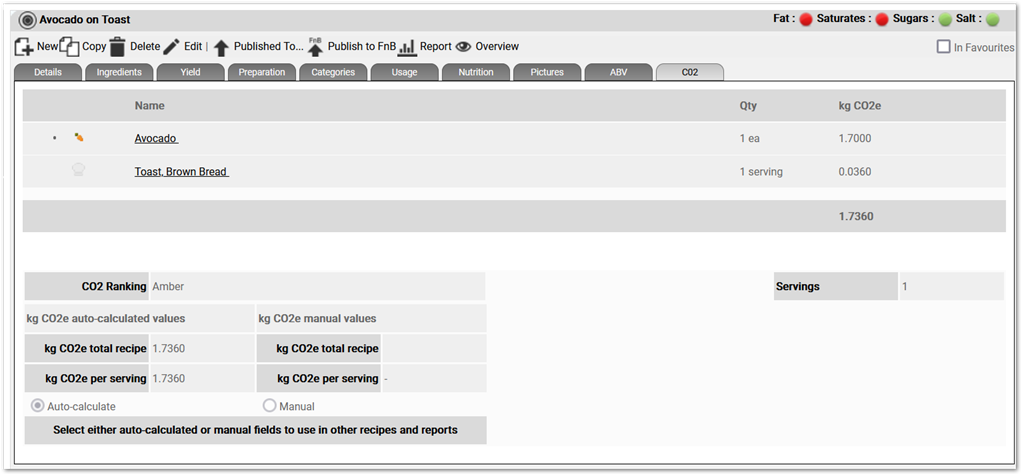CO2 footprint measurement & management
Hospitality businesses need a way to measure, manage, and ultimately reduce the CO2 footprint of their operations and offerings. To assist with this, Fourth's Recipe & Menu Engineering (RME) can:
- Hold carbon footprint data for both ingredients and recipes
- For each recipe, provide automatic CO2 impact calculations using the ingredients' footprint
- Enable Life Cycle Assessment (LCA) partners to view and update this data through our APIs
A Life Cycle Assessment (LCA) partner completes CO2 calculations on behalf of hospitality businesses. When implementing Fourth RME, the LCA and hospitality business decide whether there is any data important to calculating the CO2, such as country of origin, that should be stored with the ingredient data in Fourth.
The measurement used for the carbon footprint is the kilogram of CO2 equivalent per kilogram of ingredient (KG of CO2e per KG).
Additionally, you can also include a ranking for recipes. For example, a recipe may be ranked red, amber or green based on its footprint compared to other menu items. This is a free-text field within Fourth, enabling the hospitality business or LCA to choose how this is defined.

Through our APIs and user interface, hospitality businesses, vendors and partners can all access and contribute data. The hospitality business can choose to use Fourth to perform all recipe footprint calculations, use an LCA partner to do this, or use a combination of both Fourth and LCA functionality as desired. This flexibility supports businesses in effectively reducing their overall footprint and enabling their guest to make informed dining decisions.
Useful endpoints for CO2 management
Ingredients
Get supplier's specification for ingredients (Export API)
- GET /ingredients/{guid}/supplierspec
As well as overall product information, this endpoint provides the country of origin for an ingredient and any CO2 value that's been assigned.
Get custom fields for ingredients (Export API and Import API)
- Export: GET /ingredients/customfields and GET /ingredients/{guid}/customfields
- Import: GET /ingredientcustomfields
Provides the custom field data for each ingredient in RME. These fields can hold CO2 relevant data such as farming method or transportation.
Add or update custom fields for ingredients (Import API)
- POST /ingredientcustomfields
Enables you to add or update the custom fields for ingredients, such as farming method or transportation.
Get CO2 values for an ingredient (Import API)
- GET /ingredientco2
This simple endpoint contains just the CO2 values for one or more ingredients.
Add CO2 values for an ingredient (Import API)
- POST /ingredientco2
Enables you to update the CO2 value for one or more ingredients.
Recipes
Add or update recipe CO2 values (Import API)
- POST /recipeco2
Enables you to provide each recipe with its CO2:
- Value — CO2 equivalent per kilogram of ingredient
- Ranking — for example: Green, Yellow, Red or High, Medium, Low
Get recipe CO2 values (Export API)
- GET /recipes and GET /recipes/{guid}
This endpoint provides extensive information about recipes including the CO2 value and ranking.
Example Workflow with LCA
In this example, the LCA partner takes ingredient data from Fourth and provides a CO2 calculation back for each ingredient. Alternatively, the LCA could provide the recipe CO2 calculations based on the ingredient data.
- Vendor sends CO2 product attributes into Fourth, using one of:
- The Recipe & Menu Engineering Import API call:
POST /ingredientcustomfields - A TradeSimple integration
- A Fourth Connect integration
- The Recipe & Menu Engineering Import API call:
- The LCA exports ingredient details, using the following API calls:
- GET /ingredients/{guid}/supplierspec — for general ingredient information
- GET /ingredients/{guid}/customfields — for any custom CO2 fields
- The LCA assigns CO2 values to the ingredients, and provides these back to Fourth using the following API call:
- POST /ingredientco2
- Based on the ingredient data, Fourth RME calculates and stores the CO2 value for each recipe.
- The customer, and any relevant third-party integrator, displays the CO2 value to staff and diners.
Webhook for recipe updates
We offer a webhook option to ensure partners (third parties) can keep up-to-date with recipe data in Fourth.
The webhook payload includes the recipe name, recipe GUID and a URL that can be used to request the specified recipe via a GET request.
To subscribe to the webhook, please raise a request with Fourth's Support team, and provide us with a destination URL. If you are a partner, then you will need to ask the hospitality business (Fourth customer) to raise the request for you.
Once registered, Fourth will send a webhook request to the destination URL each time a webhook trigger occurs.
Sample webhook payload
{
"RecipeName": "Fried Bananas",
"RecipeGUID": "6c3fec7d-97c9-48f8-b84e-13bb179b9fa6",
"URL": "https://.../6c3fec7d-97c9-48f8-b84e-13bb179b9fa6"
}
Triggers for the webhook
Changes to CO2-related recipe values will trigger the webhook. These include changes to a recipe's:
- Composition, such as the inclusion or exclusion of a recipe ingredient
- Ingredient UOM
- Ingredient quantity
- Ingredient ‘Wastage Removed’ status (true/false)
- 'Cooked Weight' conversion
- 'Servings' number
As well as the following operations:
- 'Delete from system' — this removes a recipe ingredient (or sub-recipe) from specified recipes and then deletes the ingredient (or recipe) from the business' RME data.
- ‘Replace in Recipes’ — this replaces a specified ingredient (or sub-recipe) with another ingredient (or sub-recipe) OR with the same ingredient (or sub-recipe) in a different quantity.